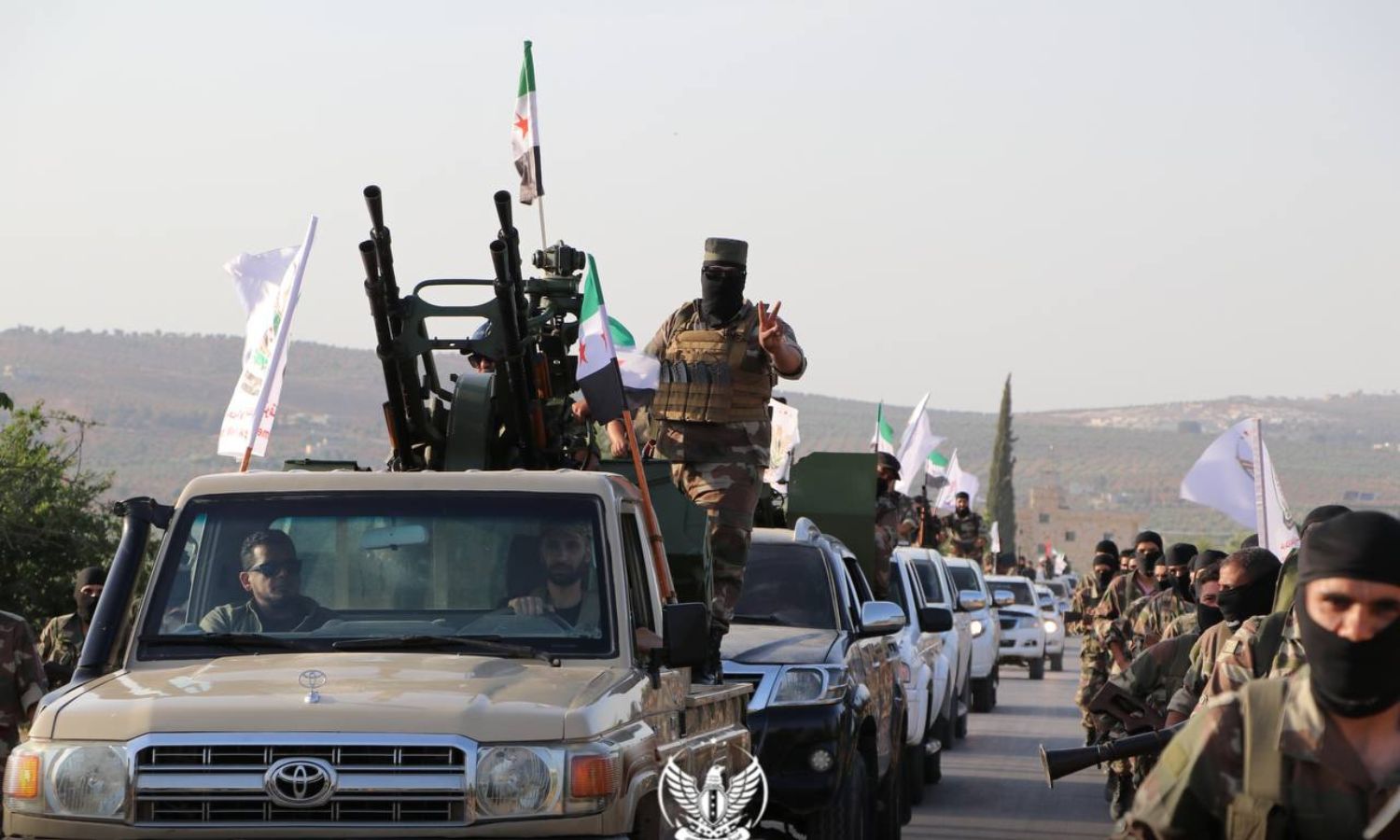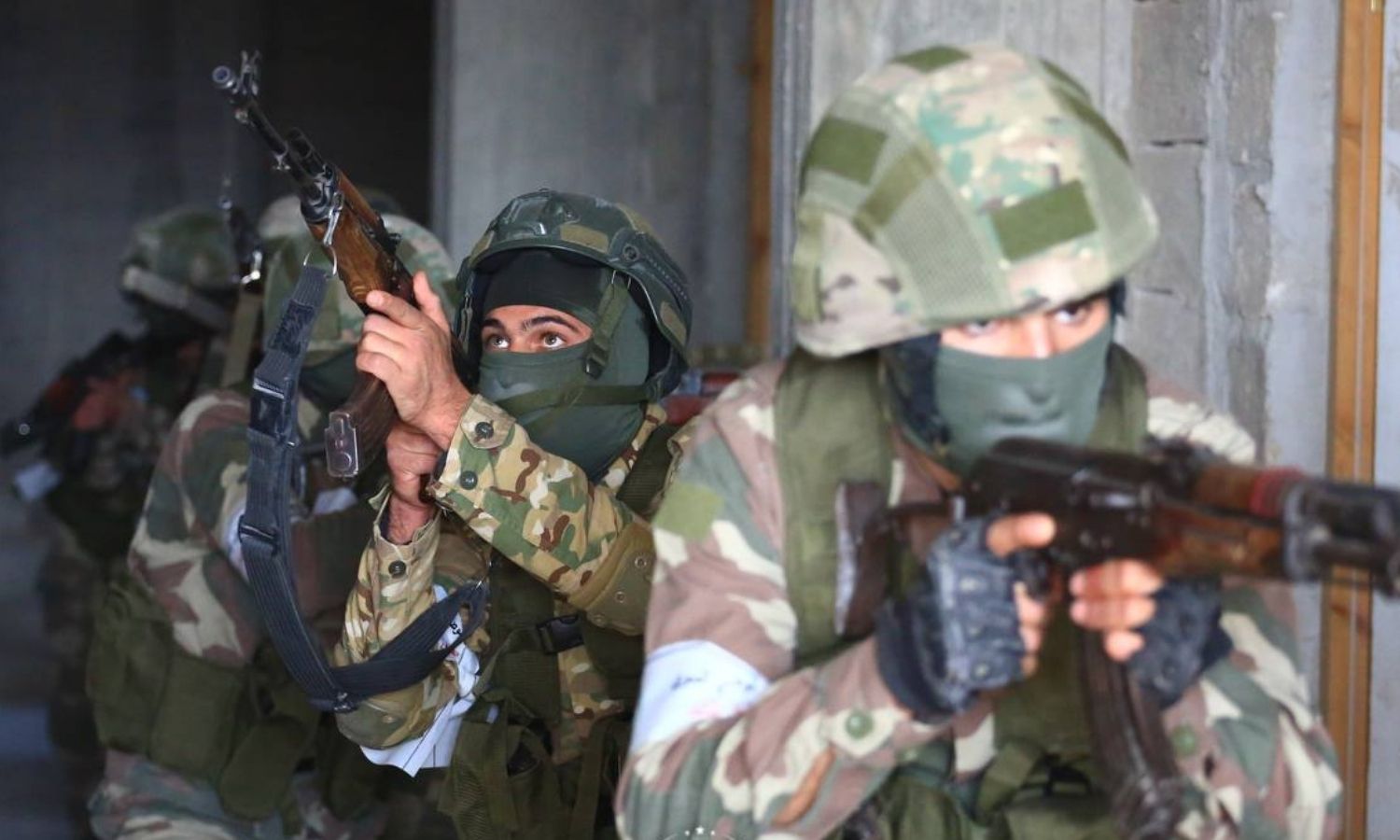



Enab Baladi – Hassan Ibrahim
Calm has returned to the city of al-Bab in the eastern countryside of Aleppo after witnessing security tension and military mobilization of factions affiliated with the Turkish-backed Syrian National Army (SNA). These factions belong to two main currents: al-Jabha al-Shamiya (the Third Legion) and the Hayat Thaeroon for Liberation (the Second Legion).
These disputes are repeated on the ground between the most prominent SNA factions. While the media shed light on it and human rights organizations document violations during it, said factions are countering them with statements affirming that “friendly and brotherly relations” bring them together.
However, attention is drawn to Hayat Tahrir al-Sham (HTS), which has military dominance over Idlib, with every dispute. Another talk is being propagated of its desire to expand its areas of control by exploiting the differences between SNA factions to advance into the Aleppo countryside.
Any change in leadership positions, figures, or mergers within the Third Legion and Thaeroon (the Second Legion) are accompanied by talk of a tendency to end or weaken the opposite faction.
The security situation in the city of al-Bab was stabilized after a military alert within the security checkpoints of al-Jabha al-Shamiya and the Thaeroon-affiliated Sultan Murad Division on the road to the Abu al-Zandin crossing that connects with regime-held areas.
On 20 September, two trucks entered the Aleppo countryside under the supervision of the Sultan Murad Division towards regime-controlled areas. Activists and local sources said that they were carrying bulgur, but Enab Baladi was not able to verify the materials carried.
The entry of the two trucks was followed by a clash close to the crossing inside regime-held areas, and artillery shells were fired without knowledge of what had happened, followed by the closure of the crossing and the mobilization of al-Jabha al-Shamiya and Sultan Murad Division elements.
The two factions are competing over the crossings connecting the region with regime-held and SDF-controlled areas. Several SNA-affiliated factions are also accused of covering up smugglers and passing and smuggling certain items and persons in exchange for payments through such crossings, but the latter denies it.

Members of the Third Legion of the Turkish-backed Syrian National Army (SNA) in a camp in the northern countryside of Aleppo – 20 September 2022 (Third Legion / Telegram)
The Third Legion faction has made some changes at the top of the faction’s chain of command, most recently on 14 September with the appointment of Abu Faisal al-Ansari as deputy chief of staff.
Certain local social media pages circulated that the appointment of al-Ansari coincided with the appointment of Abu Humam al-Boweydani as the military commander-in-chief of the Third Legion. This was denied by the Director of the Third Legion’s Media Office, Siraj al-Din Omar, in an electronic correspondence to Enab Baladi, in which he only confirmed the appointment of al-Ansari.
On 3 August, the Third Legion’s Shura Council appointed Hussam Yassin, nicknamed Abu Yassin, as the faction’s general commander after accepting the resignation of the former commander, Muhannad al-Khalif, also known as Abu Ahmed Nour.
On 7 August, the Liwa al-Safwa faction, operating in the northern countryside of Aleppo, announced that it had left the ranks of the Hayat Thaeroon for Liberation and joined the Third Legion with 250 fighters from the city of Marea in the northern countryside of Aleppo.
Siraj al-Din explained that changes and new appointments in the Third Legion are made periodically, both at the level of general leadership and at the level of office managers and even at the level of the faction’s basic institutions.
He noted that the changes were not related to any tensions with any party but rather came within a periodic scope.

Officials of the Third Legion of the Turkish-backed Syrian National Army (SNA) -3 August 2022 (Third Legion / Twitter)
The multi-factional Hayat Thaeroon for Liberation witnessed unsuccessful attempts at integration of other factions under its banner, and two defections of a couple of its factions, although its goal was to present a united front and unified discourse according to the faction’s statement when it was formed on the 23rd of last January.
Two months after their split from Hayat Thaeroon for Liberation (the Second Legion), the Legion announced on 17 September that both the Sultan Suleiman Shah Division (al-Amshat) and the al-Hamza Division (al-Hamzat) were dismissed from the Legion’s ranks for not abiding by the decisions of its leadership.
On 19 July, various sources said that the al-Amshat and al-Hamzat factions had split from Hayat Thaeroon for Liberation, led by Fahim Issa, without any official clarification or statement about the split by the three military factions.
Military observatories operating in the area, local networks, and analysts published reports of the withdrawal and defection of the al-Hamza Division led by Seif Bolad, known as Seif Abu Bakr, and the al-Amshat Division led by Mohammed al-Jassem (Abu Amsha), from Hayat Thaeroon for Liberation. The two factions lowered the latter’s banners from their camps in the northern and eastern countryside of Aleppo.
On 24 May, the Ahrar al-Sham Movement- the Eastern Sector announced its merger with Hayat Thaeroon for Liberation with a total of 1700 elements, about two months after the East Sector attempted to defect from the Third Legion following clashes and infighting between the two factions in the village of Olan in the eastern countryside of Aleppo on 1 April.
The attempt to split from the Third Legion and merge with Hayat Thaeroon for Liberation was unsuccessful following the intervention of the National Committee for Reconciliation emanating from the Ministry of Defense in the Syrian Interim Government (SIG), the political umbrella of the Syrian National Army (SNA).
The Syrian National Army (SNA), whose formation was announced in October 2019 in the city of Şanlıurfa, southern Turkey, by a group of military leaders in the Syrian opposition led by the Minister of Defense in the Syrian Interim Government (SIG) and the Chief of Staff at the time, Salim Idris, witnessed many instances of integration and defection of factions under its banner and failed to end its factional situation.
Recently, there was talk of an initiative for a “one military body” that would bring together the three SNA legions under a unified command that includes all factions and components.
The Director of SNA’s Moral Guidance Department, Hassan al-Daghim, said in electronic correspondence with Enab Baladi that efforts were continuing and that the initiative would be made public once it matures.
On 22 September, the leader in Hayat Thaeroon for Liberation, Mustafa Sejari, posted that Thaeroon is pushing for the unification of the factions and overcoming some differences and that any disagreement between SNA formations is “a dispute between family members and does not exceed diligence in controversial issues concerning management and leadership.”
One of the most prominent attempts at rapprochement between the two currents was the Unified Command Room (Azm) attempt, which was led by Muhannad al-Khalif, known as Abu Ahmed Nour, the commander of the Third Legion.
However, Azm’s attempts to hold the commander of the Sultan Suleiman Shah Division, Mohammed al-Jassem (Abu Amsha), accountable collided with the difficulty of applying it on the ground, creating a new divide between its components.
After Abu Amsha was convicted of numerous violations, he appeared in a leadership position within Hayat Thaeroon for Liberation on 15 March. Despite Azm’s promises to hold the perpetrators of violations accountable and to transfer the files to the judiciary, such promises were not kept.
The appearance of Abu Amsha as a member of the leadership council of Hayat Thaeroon for Liberation revealed the rift between Azm and Thaeroon. Azm was in a state of stalemate as a result of growing disagreements between its components on economic and organizational aspects, according to a study published by the Jusoor for Studies center on 14 March.
The study confirmed that the components of Azm, specifically the Third Legion and Hayat Thaeroon for Liberation, were unable to resolve disputes about the operational mechanism of the commercial crossings and the resulting financial return, reflected in the project of establishing an Azm-based authority to control roads and combat smuggling. The project was suspended as the security room’s work was almost frozen.
Accusations emerged that Azm, led by Abu Ahmad Nour (formerly commander of the Third Legion), had commenced holding Abu Amsha accountable to prove that the Third Legion had greater legitimacy in “fighting corruption and holding perpetrators accountable,” thereby “further enhancing its influence.”
The Jusoor for Studies center’s study showed that, since its inception, Azm was unable to set a clear definition of the relationship with SIG’s institutions, prompting official figures and some factions to oppose the Unified Command Room’s activity.
The disagreement was reinforced by the fact that some Hayat Thaeroon for Liberation factions had failed to obtain their own seats within Azm, although they were originally represented by Thaeroon, according to the study.

Fighters in the Third Legion of the Syrian National Army (SNA) in the northern countryside of Aleppo – 19 November 2021 (Third Legion)
With each dispute between SNA factions, the conversation is divided into two currents, the first of which speaks of “collusion” or “cooperation” with Hayat Tahrir al-Sham (HTS) to exclude the other party, and the second of which speaks of HTS’ desire to exploit differences and to fight the SNA factions for control of the region.
The most prominent of these tensions was last June, when HTS-affiliated military convoys headed towards the areas of Aleppo countryside and entered from the al-Ghazawiya crossing towards Afrin, north of Aleppo, to the village of al-Basouta, with more than 400 vehicles, and from the Deir Ballout crossing with more than 350 vehicles, following clashes between the Ahrar al-Sham – Eastern Sector faction (32nd Division) and the Third Legion.
Relations between the Syrian National Army (SNA) factions have been marred by a lack of compatibility, harmony, and coordination with Hayat Tahrir al-Sham (HTS) since the regions of northern Syria were divided between them in terms of military and services in 2017.
The state of hostility began in 2014 with a dispute between Hayat Tahrir al-Sham (HTS) (the al-Nusra Front at the time) and several other factions, when HTS worked to extend its influence over the region to be the only dominant and influential military body. Idlib governorate witnessed many disputes between the HTS and other factions affiliated with the Syrian opposition and the Free Syrian Army (FSA).
These disagreements were followed by several tensions between HTS and fighter factions in the north that weighed heavily and affected battles against the Syrian regime and its allies, most notably the Ahrar al-Sham Movement.
The poor relations between the two parties during these years did not prevent some leaks or statements conveyed by some faction leaders on both sides, which spoke of mutual visits and the possibility of a merger or consensus between Syrian National Army (SNA) factions and Hayat Tahrir al-Sham (HTS).
if you think the article contain wrong information or you have additional details Send Correction